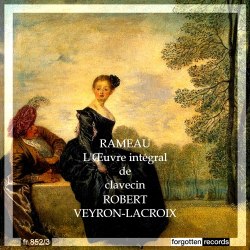|

|
Jean-Philippe RAMEAU (1683-1764)
Premier Livre de Pièces de Clavecin (1706)
Pièces de Clavecin (1724, edited 1731)
Nouvelles Suites de pièces de Clavecin, ou Second Livre (1728)
Cinq Pièces, extradites des Pieces en Concert (1741)
Robert Veyron-Lacroix (harpsichord)
rec. 1955, Paris
FORGOTTEN RECORDS FR852-53 [68:34 + 69:49]
Forgotten Records has shown due discrimination in its selection of the recordings of harpsichordist (and pianist) Robert Veyron-Lacroix. All are worthy of their catalogue of remastered LP recordings, this one being a twofer devoted to his 1955 traversal of the solo keyboard music of Rameau. As a nice pendant we also have those five pieces extracted from the Pièces de clavecin which were originally composed for the ensemble of harpsichord, flute (or violin), and viola da gamba.
The state of the Rameau solo keyboard discography at the end of the 78 era was desultory. Only a few musicians, such as Ahlers, Guilbert and Landowska, as well as isolated recordings by such as Casadesus, offered much sustenance and no-one had begun to take a collective look at the repertory - certainly no single record label had seen it as a worthwhile opportunity: there was no subsidised Rameau Society. One musician who had recorded a little Rameau, however, was Marcelle Meyer and of keyboard players in the pre-stereo age, it was Meyer who was to establish the composer as a valid object for investment and recording. Her piano sides have been reissued by EMI and Les Introuvables de Marcelle Meyer, volume 2 is especially noteworthy (4 CDs; 5 68092 2). Her insights and pianism remain touchstones of performance in this repertoire. It’s worthwhile to note that shortly after she began her sequence in 1953 - it took another couple of years to complete - across town Veyron-Lacroix got to work with his harpsichord. The two musicians, very different in aesthetic approach, much less chosen instrument, were actually recording pretty much contemporaneously.
He played a Pleyel harpsichord but there is, naturally, a world of difference - aesthetic, interpretative, sonic - between his sound and that of Landowska; you only have to listen to three bars of their respective recordings of La Dauphine to hear that. Veyron-Lacroix, sonata partner of Rampal, collegiate friend of Grumiaux, was a player ready for the renaissance of historically informed practice as it developed post-war. His registrations are subtle, his touch elegant, and his sense of movement established through a fine rhythmic sense. Characterisation is always at the service of the music, even when it’s at its most descriptive - birdcalls, village dances, the Hen and the rest of Rameau’s inspired menagerie of pictorial imaginings. He cultivates great dignity of expression - the Allemande in the 1724 set is a case in point - and brings imagination to bear even on so well-known a piece as the same collection’s Tambourin. Accenting in the Courante of the Nouvelles Suites is beautifully calibrated and the Gavotte, with six doubles, is loftily phrased, with panache in the faster doubles but space elsewhere.
There are occasional recording oddities. Is there artificial volume boosting at the end of the double in Les Niais de Sologne? Still, such things only add to the pleasure of a recording now nearly sixty years old. These recordings stand with Marcelle Meyer’s as representing two distinct traditions of Rameau performance in the mid-1950s in Paris, and have been very worthily, indeed excellently transferred by Forgotten Records.
Jonathan Woolf
 |
 |
|
